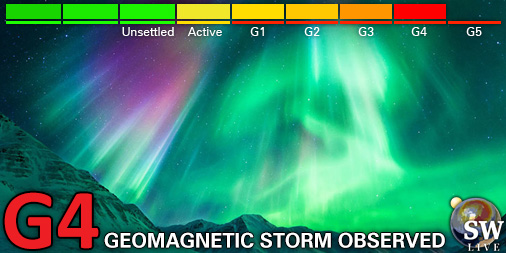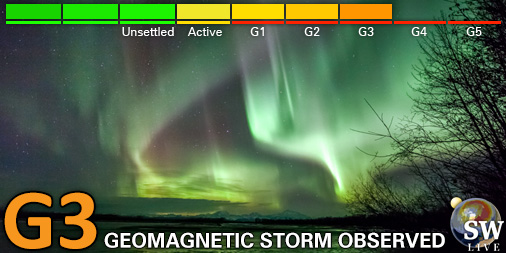Viewing archive of Saturday, 20 October 2001
Solar activity report
Any mentioned solar flare in this report has a scaling factor applied by the Space Weather Prediction Center (SWPC). Because of the SWPC scaling factor, solar flares are reported as 42% smaller than for the science quality data. The scaling factor has been removed from our archived solar flare data to reflect the true physical units.
Report of Solar-Geophysical Activity 2001 Oct 20 2200 UTCPrepared by the NOAA © SWPC and processed by SpaceWeatherLive.com
Joint USAF/NOAA Report of Solar and Geophysical Activity
SDF Number 293 Issued at 2200Z on 20 Oct 2001 ::::::CORRECTED COPY:::::::IA. Analysis of Solar Active Regions and Activity from 19-2100Z to 20-2100Z
Solar activity was at moderate levels. Region 9658
(S15W73) produced an M3/1f flare at 20/2325 UTC and associated
discrete frequency radio bursts. Other activity was centered around
Region's 9661 (N15W48) and 9670 (S19E19). Both of these regions
produced minor C-class flares though the course of the period.
Region 9661 was generally stable and has shown gradual decay as the
magnetic delta configuration is no longer apparent in regions spot
group. Two new regions were numbered today, Region 9675 (S14E69),
and Region 9676 (N13E70).
IB. Solar Activity Forecast
Solar activity is expected to be at
moderate to high levels. Region 9661 still remains capable of
producing an M-class or isolated major flares.
IIA. Geophysical Activity Summary 19-2100Z to 20-2100Z
The geomagnetic field was predominantly at quiet to unsettled levels.
Brief active conditions were observed at both the middle and high
latitudes in the 20/1200-1500 UTC period. The greater than 10 MeV
proton flux at geosynchronous orbit passed the 10 pfu threshold at
19/2225 UTC, reached a maximum of 11 pfu at 19/2235 UTC. The short
lived 10 MeV proton event ended at 19/2255 UTC though flux levels
remained elevated at time of bulletin issue.
IIB. Geophysical Activity Forecast
The geomagnetic field is
expected to be at quiet to minor storm levels with the possibility
of isolated major storm conditions late on day one and through day
two of the period. Analysis of the full halo CME, on LASCO imagery
(X1/2b flare at 19/0105 UTC from Region 9661), indicated shock
arrival late on day one or early on day two. A second full halo CME
(X1/2b flare at 19/1630 UTC from Region 9661) is expected to arrive
late on day two of the period. The greater than 10 MeV proton flux
levels from geosynchronous orbit could remain elevated through first
day of the period.
III. Event Probabilities 21 Oct to 23 Oct
| Class M | 70% | 70% | 70% |
| Class X | 15% | 15% | 15% |
| Proton | 15% | 15% | 15% |
| PCAF | Yellow | ||
IV. Penticton 10.7 cm Flux
Observed 20 Oct 245 Predicted 21 Oct-23 Oct 245/240/235 90 Day Mean 20 Oct 190
V. Geomagnetic A Indices
Observed Afr/Ap 19 Oct 006/008 Estimated Afr/Ap 20 Oct ???/??? Predicted Afr/Ap 21 Oct-23 Oct 025/030-030/035-015/025
VI. Geomagnetic Activity Probabilities 21 Oct to 23 Oct
| A. Middle Latitudes | |||
|---|---|---|---|
| Active | 55% | 55% | 40% |
| Minor storm | 30% | 30% | 10% |
| Major-severe storm | 05% | 05% | 01% |
| B. High Latitudes | |||
|---|---|---|---|
| Active | 55% | 55% | 45% |
| Minor storm | 30% | 30% | 15% |
| Major-severe storm | 10% | 10% | 05% |
All times in UTC
Latest news
Latest forum messages
2025/04/12-13 Filament CMEs 2025/04/16 G3 Watch 473Coronal holes 51Filaments and prominences 67AR4064 9Incoming & Unnumbered Active Regions 1742
More topicsSupport SpaceWeatherLive.com!
A lot of people come to SpaceWeatherLive to follow the Sun's activity or if there is aurora to be seen, but with more traffic comes higher server costs. Consider a donation if you enjoy SpaceWeatherLive so we can keep the website online!

Latest alerts
Wednesday, 16 April 2025
21:45 UTC - Geomagnetic activity
Minor G1 geomagnetic storm (Kp5) Threshold Reached: 21:36 UTC
21:00 UTC - Geomagnetic activity
Severe G4 geomagnetic storm (Kp8) Threshold Reached: 20:55 UTC
19:45 UTC - Geomagnetic activity
Strong G3 geomagnetic storm (Kp7) Threshold Reached: 19:25 UTC
19:00 UTC - Geomagnetic activity
Moderate G2 geomagnetic storm (Kp6) Threshold Reached: 18:38 UTC
18:45 UTC - Geomagnetic activity
Minor G1 geomagnetic storm (Kp5) Threshold Reached: 18:28 UTC
Space weather facts
| Last X-flare | 2025/03/28 | X1.1 |
| Last M-flare | 2025/04/15 | M1.2 |
| Last geomagnetic storm | 2025/04/16 | Kp8- (G4) |
| Spotless days | |
|---|---|
| Last spotless day | 2022/06/08 |
| Monthly mean Sunspot Number | |
|---|---|
| March 2025 | 134.2 -20.4 |
| April 2025 | 120.7 -13.5 |
| Last 30 days | 120.8 -19.6 |







